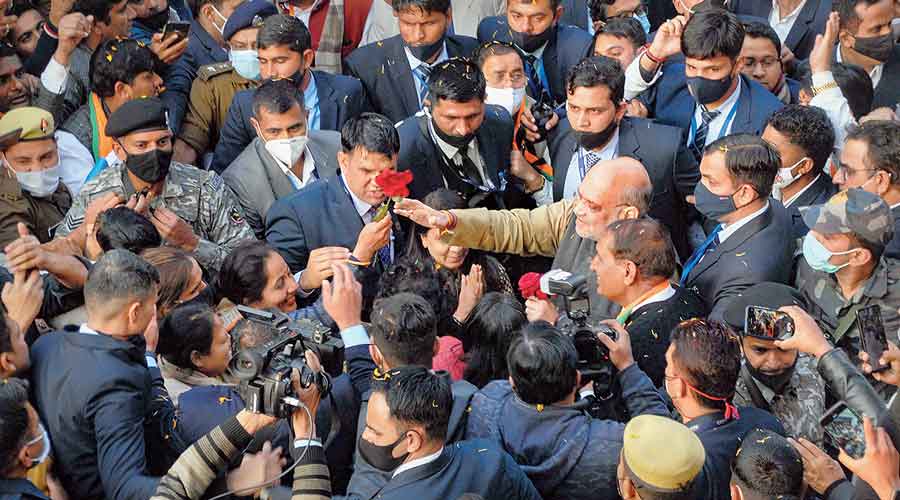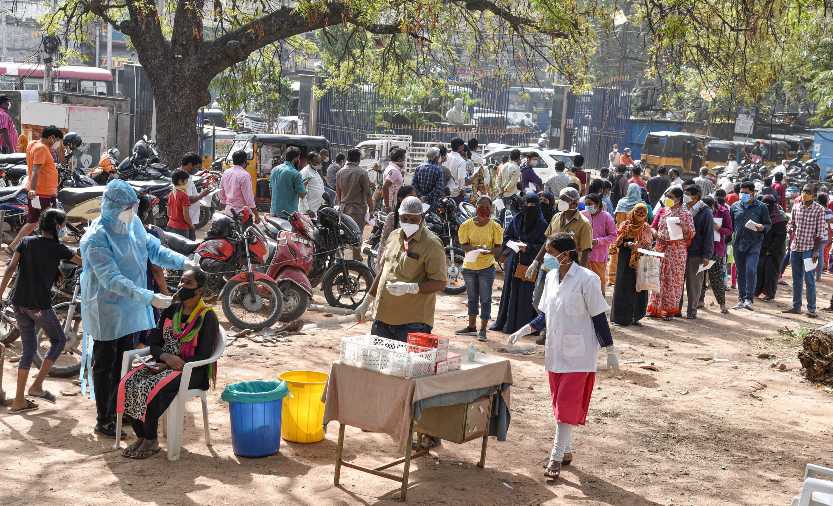India’s third Covid-19 wave is approaching a plateau, the Union health ministry said on Thursday, amid declining daily new infections in many districts and indications that omicron has displaced the more virulent delta in most states.
“There are early indications of a plateau over the past five to seven days — this is only limited to certain geographies,” said Lav Agarwal, joint secretary in the Union health ministry.
Health officials said omicron — a fast-spreading, immune-evasive variant associated with mild disease — made up two-thirds of the sequences sampled nationwide in January, but cautioned that delta remained in circulation, especially in Bengal, Maharashtra and Odisha.
The number of omicron sequences found through a nationwide genome sequencing effort increased more than sevenfold from 1,292 during December to 9,672 during January, said Sujeet Singh, director, National Centre for Disease Control, the lab coordinating the effort.
The counts of delta sequences fell from around 17,200 in December to roughly 4,700 during January.

...Left hand doesn’t: Without a mask and with little physical distancing, Union home minister Amit Shah campaigns for the Uttar Pradesh polls in Greater Noida on Thursday. PTI picture
“Our sequencing data suggests that delta is circulating mainly in three states — Odisha, Bengal and Maharashtra,” Singh said.
“But this does not mean omicron has completely taken over. We do see delta in circulation here and there, including Delhi.”
It is critical, Singh said, that when Covid-19 patients reach hospitals, they are not expected to only have mild infections because delta remains in circulation and certain patients with co-morbidities are at risk of severe disease.
The growing proportion of omicron sequences and falling counts of daily new infections — mainly in large cities and towns — have stirred hope that omicron, the variant driving the current wave, is running out of people to infect.
Bangalore, Chennai, Gurgaon, Noida, Lucknow, Mumbai and Khordha (Odisha) are among districts with declining new infections and test positivity rates, both indications of shrinking epidemics.
But signs of large epidemics persist in 407 districts, including 33 in Maharashtra, 32 in Tamil Nadu, 28 in Assam, 27 in Karnataka and 18 in Bengal, where the test positivity rates continue to remain higher than 10 per cent.
Union home secretary Ajay Bhalla wrote to state chief secretaries on Thursday urging that district administrations lift local curbs only after considering the test positivity rates and hospitalisation levels.
Despite signs of a nationwide plateau, the daily new infections and test positivity rates have increased over the past week in several districts, including Ahmedabad, Ernakulam, Kozhikode, Thiruvananthapuram, Nagpur and Pune.
Health officials say the sharp differences in the seven-day average daily deaths – against comparable counts of daily new infections -- during the current wave and the second wave last year owe to the country’s expanding vaccination coverage.
India lost on average 3,679 people daily during the week when the second wave peaked with 414,000 new infections on May 7 last year, but the average daily deaths over the past week has been 435 against daily new infections of 347,000.
Vaccine upgrade
India’s drug regulatory authority has granted “conditional market authorisation” to Covishield and Covaxin, allowing manufacturers of the two Covid-19 vaccines to submit safety data at longer time intervals. But the vaccination rules for recipients remain unchanged.
The health ministry said on Thursday that the Central Drugs Standard Control Organisation had recommended that the two vaccines be upgraded from their status of “restricted use in emergency situations” to conditional market authorisation.
The upgraded status implies that the vaccine makers would henceforth need to submit any data on adverse events following immunisation once in six months instead of once in two weeks, as until now.
However, the vaccines will continue to be administered and be available to recipients under the existing guidelines for the Covid-19 immunisation campaign set by the Centre.











